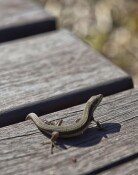Blood-Covered Barracks
On both sides of the one-lane road, there were two lines of barbed wire with red signs that read land mines. I arrived at a check point (CP) in the rear after passing a civilian passage restriction line sixteen minutes ago. Since buses were not allowed from that point, I had to go by jeep. Ten minutes bumpy ride on an unpaved road brought me to the iron railings of the southern limited line in the Demilitarized Zone (DMZ).
In order to visit the spot of the killing rampage on June 21 by a Korean Army private, I wore a bullet proof vest and put on a bullet proof helmet offered by the Ministry of National Defense. After leaving my mobile phone with a military official, I got on the jeep again.
The iron railings of the southern limited line lie two kilometers away from the guard post in the foremost front line in Yeoncheon-gun, northern Gyeonggi province. The guard post is the place where the killing by Private First Class Kim Dong-min (22) took place. At the post the South Korean army confronts the North Korean Army, and it is closer to the guard post of North Korea than to iron fences on the side of South Korea by 500 meters.
Built in the early 1980s, the guard post is more like a concrete mass than a building. Concrete walls surrounding the post are 30 centimeters thick. Even though it was camouflaged with paint, colors of the walls are faded and some parts of the walls are peeling off.
At the entry to barracks, there were two puddles of stagnant blood. There was an identification tag stuck in one of them. The blood was still wet, so footprints were covered with blood. I felt sick because of bullet marks, broken pieces in the ceiling, blood puddles, and damp air.
In the 15-pyeong barracks, mattresses used by soldiers were laid wall to wall. The width in which one person can lie is only 90 centimeters, the same width as that of lockers. Khaki color bedclothes with fluff were very dirty. Underwear and socks were hanging on covers of fluorescent lamps and clothes hangers densely, indicating that there was no place to dry clothes. Photographs of family members and friends were on the lockers with peeled-off sky blue paint.
The damage from the explosion of hand grenades was mostly done on the right side of the door where Private Kim threw the grenade and fired bullets with a rifle. The spot where the grenade exploded left a football-size hole in the tattered mattress. There were small blackish lumps on the ceiling. They were not pieces of the exploded grenade but cotton wool and pieces of flesh.
The damage from the explosion was reduced by 50-60 percent because the grenade went off under the stomach of soldier Park Eui-won, explained the head of the investigation of the military police.
The body of Park was lying facing down not in the place where he used to sleep but under a locker. However, the possibility of Park falling down on the grenade is not being considered, according to the military.
The gym where the dead body of Kim Jong-myeong, a lieutenant, was found was covered with blood. He allegedly died roaming the gym and bleeding, not dying on the spot. Bullet marks remained on the walls. There was audio used by private soldiers in the corners of the gym and books including boring ones such as comic novel Samgukji, many bibles on the shelf labeled as religious books, and 12 copies of the New Testament which seemed to be touched by no one.
The surrounding area was burned. The North Korean Army set fire every winter. No one knows when the North Korean Army will come, a military officer explained. The officer said the soldiers deserve our pity.
In their prime years they had to be stuck in the same place 24 hours a day for three months with the same people, thinking that the breakout of war would mean their death.
The guard post in question gave me the impression that it was like a prison made carelessly by barbed wire. Barbed wire surrounded the concrete camp and cylindrical barbed wire loops were hung on the fence-style wires.
There was little room between the barbed wire and the nearby building. The drill ground of the guard post was the size of a garden of a house.
Kang-Myoung Chang tesomiom@donga.com







